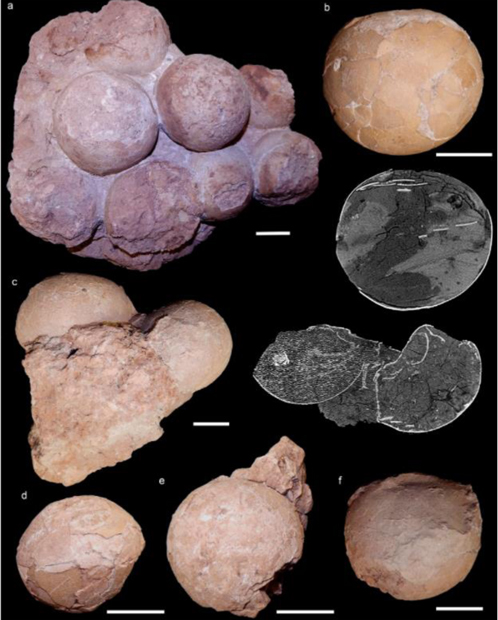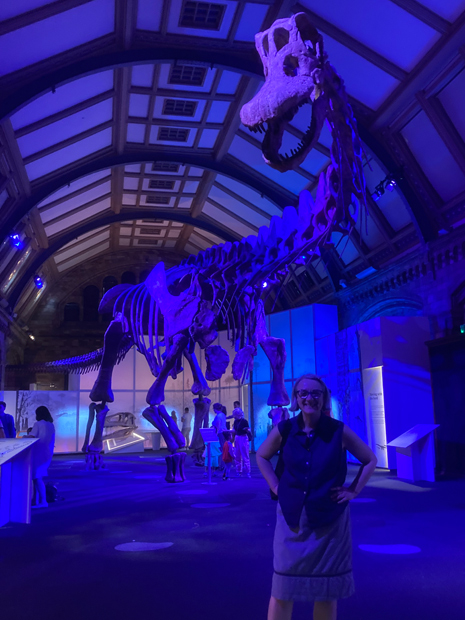First Titanosaur Nesting Site from the Late Cretaceous of Brazil
Scientists have identified the first confirmed dinosaur nesting site in Brazil. The fossilised eggs found suggest a colonial titanosaur nesting site and indicate individuals returning periodically to the same location to breed. A paper has been published in the journal “Scientific Reports”.
The fossils consisting of preserved clutches and isolated egg fragments were excavated from sandy deposits in an abandoned limestone quarry (Lafarge Quarry) at Ponte Alta District, Uberaba Municipality in Minas Gerais State (south-eastern Brazil). The fossils were recovered from the Serra da Galga Formation (Upper Cretaceous) and although no fossilised embryos were found at the site, the shape of the eggs strongly suggest that they were laid by titanosaurs.

Images of selected titanosaurian eggs and egg-clutches collected from the Late Cretaceous Serra da Galga Formation (Bauru Group) at Ponto Alta nesting site, Uberaba Municipality, Minas Gerais State, Brazil. CPPLIP 1798, (a) the best-preserved recovered egg-clutch, bottom view. CPPLIP 1801, (b) isolated egg, with accompanying tomographic slice, showing thickness of the shell and its sedimentary fill. Specimen number CPPLIP 1799, (c) egg-clutch with accompanying tomographic slice, showing thickness of the shell, shells collapsed and its sedimentary fill. The specimen number CPPLIP 1800, (d and e) two eggs found associated. Specimen number CPPLIP 1804 (f) isolated partial egg. Note scale bars 5 cm. Picture credit: Fiorelli et al.
Picture credit: Fiorelli et al
Nesting in Colonies and Evidence of Breeding-site Fidelity
The Titanosauria were a highly successful clade of long-necked, long-tailed herbivores that were globally distributed during the Cretaceous and survived up until the very end of the Mesozoic. Some of the biggest terrestrial animals known to science are members of this clade, dinosaurs such as Patagotitan, Argentinosaurus and Notocolossus. All three of these titanosaurs lived millions of years before the Lafarge Quarry eggs were laid and they lived much further south (higher palaeolatitude).

A scale drawing of the giant titanosaur Patagotitan mayorum commissioned by Everything Dinosaur. This huge dinosaur was estimated to have measured around 35 metres when its fossil bones were initially examined. When Patagotitan was formally named and scientifically described its body size and weight was reduced slightly. However, a reconstructed, life-size skeleton was built measuring 37.2 metres in length. Titanosaurs are amongst the largest terrestrial animals known to science. Picture credit: Everything Dinosaur.
Picture credit: Everything Dinosaur
Numerous titanosaur nesting sites are known (Spain, Romania, France, India and most notably Argentina), writing in the academic journal “Scientific Reports”, the researchers report the first titanosaur nesting site from the Late Cretaceous of Brazil (Maastrichtian faunal stage). The fossil material consisting of several egg-clutches, partially preserved, isolated eggs and many eggshell fragments were found in two distinct levels, approximately two metres apart.
This discovery adds further support to the theory that these large herbivores nested in colonies and had preferred locations for their nesting sites, what is often referred to as breeding-site fidelity.
To read a related blog post about breeding-site fidelity (philopatry) identified in South American titanosaurs: Two New South American Titanosaurs Described.

The titanosaur egg fossils were found in two distinct layers (L1 and L2) approximately two metres apart. This suggests that this area was a preferred nesting site for titanosaurs. This is the first confirmed dinosaur nesting area found in Brazil. The eggs attributed to titanosaurs also represent the most northerly titanosaurian nesting site known from South America. The discovery of nests located at different levels indicates that titanosaurs returned regularly to preferred nesting areas. Picture credit: Fiorelli et al.
Picture credit: Fiorelli et al
Which Titanosaur Species?
Isolated and fragmentary remains of titanosaur eggs had previously been reported from Brazil, but the Lafarge Quarry specimens provide unambiguous proof of titanosaur nesting in Brazil. As no embryos have been found in association with the fossilised eggs, it is not possible to comment on the specific genus involved.
However, the researchers state that between the Santonian to the Maastrichtian faunal stages of the Late Cretaceous (86 to 66 million years ago) only derived titanosaurs such as saltasaurids and colossosaurians are recorded from South America. It is likely that the fossils associated with the nesting site represent an unknown genus.

Sue from Everything Dinosaur poses in front of the colossal Patagotitan skeleton which is being exhibited at the Natural History Museum (London). Picture credit: Everything Dinosaur.
Picture credit: Everything Dinosaur
During the Late Cretaceous the Ponte Alta District would have been located at around 26 degrees south of the Equator, putting it on a similar palaeolatitude of titanosaur nesting sites found in India. Previously, South American titanosaur nesting sites have been recorded between 33 to 47 degrees south of the Equator. This latitudinal difference could also influence the distribution of species on the Gondwana continent. The palaeoclimatic variation and geological characteristics could result in a difference in nesting time between titanosaurs living at different latitudes.
How Did Titanosaurs Build Nests?
The Lafarge Quarry site indicates colonial nesting which also suggests that these herbivorous dinosaurs moved around in herds. It is likely that Ponte Alta District titanosaurs scooped out pits in the soft sand using their back legs and then laid their eggs in clutches, before burying them and perhaps covering the nest with vegetation to help incubation.
To read an article about the naming of Austroposeidon magnificus the largest dinosaur from Brazil described to date: Brazil’s Biggest Dinosaur.
The scientific paper: “First titanosaur dinosaur nesting site from the Late Cretaceous of Brazil” by Lucas E. Fiorelli, Agustín G. Martinelli, João Ismael da Silva, E. Martín Hechenleitner, Marcus Vinícius Theodoro Soares, Julian C. G. Silva Junior, José Carlos da Silva, Élbia Messias Roteli Borges, Luiz Carlos Borges Ribeiro, André Marconato, Giorgio Basilici and Thiago da Silva Marinho published in Scientific Reports.
The award-winning Everything Dinosaur website: Dinosaur Models.

